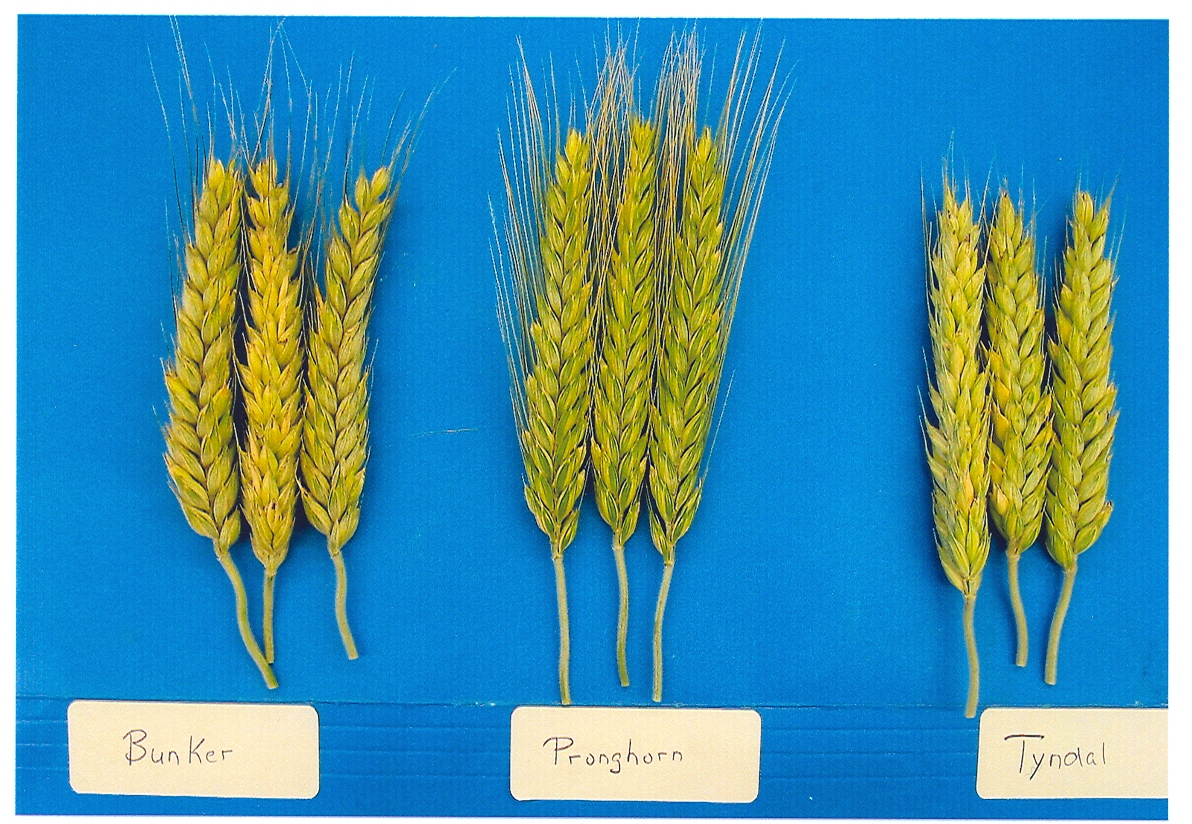Tyndal
| Denomination: | 'Tyndal' |
|---|---|
| Botanical Name: | ×Triticosecale |
| Applicant/Holder: |
Alberta Agriculture and Irrigation Crop Assurance and Rural Programming Branch 1st Floor, 7000-113 Street Edmonton, Alberta T6H 5T6 Canada |
| Breeder: |
Donald F. Salmon, Alberta Agriculture and Rural Development, Lacombe, Alberta |
| Agent in Canada: |
SeCan Association 400-300 Terry Fox Drive Kanata, Ontario K2K 0E3 Canada Tel: 613-592-8600 ext.223 |
| Application Date: | 2006-04-12 |
| Application Number: | 06-5428 |
| Grant of Rights Date: | 2007-12-05 |
| Certificate Number: | 3092 |
| Grant of Rights Termination Date: | 2025-12-05 |
Variety Description
Varieties used for comparison: 'Bunker' and 'Pronghorn'
Summary: 'Tyndal' is a hexaploid, spring triticale variety which has shorter plants than the other candidate variety 'Bunker'. 'Tyndal' has an erect flag leaf and medium intensity of anthocyanin colouration on the flag leaf auricles, whereas 'Bunker has a drooping flag leaf and both 'Bunker' and the reference variety 'Pronghorn' have no anthocyanin on the auricles. 'Tyndal is an awnletted variety, whereas 'Pronghorn' is fully awned. 'Tyndal' has a shorter and wider spike than 'Pronghorn'.
Description:
COLEOPTILE: weak anthocyanin colouration
PLANT AT BOOTING: semi-erect growth habit
FLAG LEAF: erect, moderate anthocyanin colouration on auricles, medium glaucosity
PLANT AFTER HEADING: tall, mid season maturity, moderately thick pith of straw
NECK OF CULM: moderately curved, dense pubescence
SPIKE: medium density, medium glaucosity, slightly coloured, broad
AWNS: reduced (at tip only), very weak or no anthocyanin colouration
LOWER GLUME: medium length first beak, small second beak, hairy on external surface
ANTHERS: medium intensity anthocyanin colouration
KERNEL: red colour, large size, medium length and width, elliptical shape, dark phenol reaction
AGRONOMIC TRAITS: good resistance to shattering, good tolerance to drought, medium pre-harvest sprouting tendency
REACTION TO DISEASE: resistant to powdery mildew (Erysiphe graminis f.sp. tritici), common bunt (Tilletia caries, Tilletia foetida), dwarf bunt (Tilletia controversa), loose smut (Ustilago tritici), leaf rust (Puccinia triticina), stem rust (Puccinia graminis f.sp. tritici) and stripe rust (Puccinia striiformis), moderately resistant to Septoria nodorum blotch (Septoria nodorum), moderately susceptible to Fusarium head blight (Fusarium graminearum), susceptible to spot blotch (Cochliobolus sativus), tan spot (Pyrenophora triticirepentis), Septoria tritici blotch (Septoria tritici)
Origin & Breeding History: 'Tyndal' (which was tested in Coop trials as T182) is derived from the cross Nimir-1/Hare-265//Erizo-9/3/88L012, produced at the Field Crop Development Centre, Lacombe, Alberta in 1994. The germplasm line Nimir-1/Hare-265//Erizo-9 was an introduction from the Centro Internacional de Mejoramiento de Maiz y Trigo (CIMMYT) and 88L012 was an awnletted triticale developed at the Field Crop Development Centre. The awnletted characteristic in 88L012 came from a triticale × spring wheat cross (RL4137) backcrossed several times to spring triticale, including a sister line to 'Pronghorn'. The F2 was grown in the field in 1995 and subjected to selection for degree of awn reduction. The F3 - F5 generations were handled in a modified bulk using plant type and degree of awn reduction as the primary selection criteria. The F6 - F7 were subsequently evaluated for agronomic type as headrows at Lacombe. T182 (94L043017) was evaluated in preliminary trials from 1998 to 2001 and in the Western Spring Triticale Coop Test from 2002-2004. The awnletted characteristic in T182 ('Tyndal') comes from the same source as the winter triticale variety 'Bobcat'.
Tests & Trials: Trials for 'Tyndal' were conducted during the summers of 2005 and 2006 at the Field Crop Development Centre, Lacombe, Alberta. Each plot was replicated 3 times and seeded at a rate of 30 seeds/square foot. Plots consisted of 8 rows, planted at a length of 4.5 metres and cut back to 2.5 metres. The rows were 14 cm apart and plots were 45 cm apart. Measured characteristics were based on a minimum of 30 measurements.
Comparison tables for 'Tyndal' with reference varieties 'Bunker' and 'Pronghorn'
Flag leaf length (cm)
| 'Tyndal' | 'Bunker' | 'Pronghorn' | |
|---|---|---|---|
| mean | 16.8 | 21.1 | 17.3 |
| std. deviation | 2.8 | 2.03 | 2.12 |
Flag leaf width (mm)
| 'Tyndal' | 'Bunker' | 'Pronghorn' | |
|---|---|---|---|
| mean | 14.85 | 17.7 | 14.7 |
| std. deviation | 2.4 | 1.6 | 1.69 |
Plant height, including awns (cm)
| 'Tyndal' | 'Bunker' | 'Pronghorn' | |
|---|---|---|---|
| mean | 118.0 | 132.6 | 121.4 |
| std. deviation | 4.9 | 5.4 | 6.0 |
Spike length, excluding awns (cm)
| 'Tyndal' | 'Bunker' | 'Pronghorn' | |
|---|---|---|---|
| mean | 9.46 | 9.74 | 11.32 |
| std. deviation | 0.75 | 0.77 | 0.96 |
Kernel weight
| 'Tyndal' | 'Bunker' | 'Pronghorn' | |
|---|---|---|---|
| grams per 1000 kernels | 42.2 | 45.7 | 42.3 |
Click on image for larger view

Triticale: 'Tyndal' (right) with reference varieties 'Bunker' (left) and 'Pronghorn' (centre)
- Date modified: